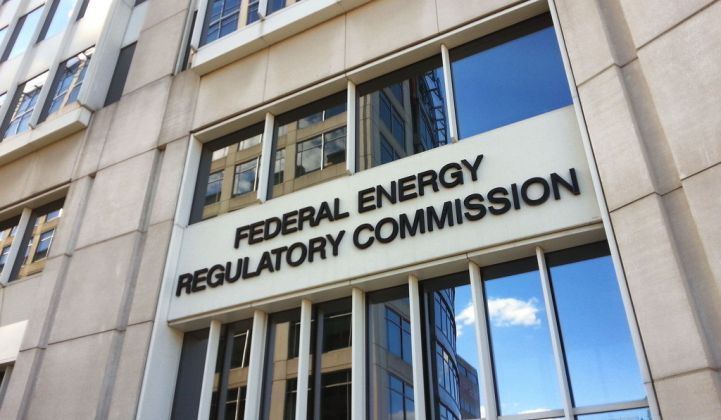Thursday’s meeting of the Federal Energy Regulatory Commission started off with expressions of comity between its three commissioners. It ended with another round of dissents from its sole Democrat, who warned of possible legal challenges to FERC decisions approved by its Republican majority over his objections.
Questions of political pressure on the avowedly nonpartisan agency have swirled around FERC over the past weeks after the Trump administration demoted Neil Chatterjee from his two-year tenure as FERC chairman to appoint fellow Republican James Danly to the leadership position.
But Chatterjee was gracious to Danly in welcoming him as chair and thanked Democrat Richard Glick for finding “common ground” amid “our fair share of political disagreements.” He also congratulated President-elect Joe Biden and Vice President-elect Kamala Harris on their election victory, making him one of the few Trump-appointed federal officials to do so.
Glick, in turn, noted that he’s had a "very good and open level of discussion” with his Republican colleagues, despite their disputes.
Glick was less sparing, however, in his dissents regarding two decisions to deny pleas from states and clean energy groups to reconsider two key FERC decisions — one applying to federally regulated wholesale energy markets in New England and the other to clean-energy facilities competing in states with vertically integrated utility regulatory structures.
Glick, who is considered a likely pick to chair FERC under the incoming Biden administration, said both decisions will have a negative impact on clean energy resources and noted that Thursday’s decisions are both open to legal challenges in federal court.
ISO New England’s CASPR policy and FERC’s impact on capacity markets
The first issue pertains to a denial of rehearing for a New England capacity market structure approved by FERC on a party-line vote in March 2018, which has since been attacked by governors and U.S. senators representing New England states as a threat to accomplishing their clean-energy policy goals.
That’s because the Competitive Auctions with Sponsored Policy Resources (CASPR) policy restricts state-subsidized, carbon-free resources like solar and wind power in how they can participate in the forward capacity market.
Glick echoed views from clean-energy advocates and New England state attorneys general that the CASPR structure “has the effect of impeding state clean-energy policies and unnecessarily raising capacity prices.”
“There are a lot of things wrong with today’s order, not the least of which is the fact that the commission waited two and a half years to hear it,” Glick added regarding the decision to deny rehearing. “That is regulatory negligence.”
The Sierra Club, Natural Resources Defense Council, Renew Northeast and the Conservation Law Foundation have already appealed FERC's decision to the U.S. Court of Appeals for the D.C. Circuit.
Ari Peskoe, director of the Electricity Law Initiative at Harvard University, noted that FERC’s subsequent actions to impose even more problematic restrictions on state-subsidized resources in the capacity market of mid-Atlantic grid operator PJM may strengthen legal challenges to ISO-NE's CASPR construct.
“One of the key legal issues in both proceedings is FERC’s authority to address state policies,” he wrote in a Thursday email. “FERC went further in PJM, and perhaps clean energy interests will be able to make more convincing arguments based on those facts.”
PURPA rule changes face challenges from solar groups
Glick also dissented to FERC’s decision to deny a rehearing of its June order changing the rules applied to independent energy projects under the Public Utilities Regulatory Policies Act (PURPA). Those changes, passed by FERC’s Republican majority against Glick’s "no" vote, will allow states to alter the contracts and payment structures that guide how utilities pay for power from independently owned projects, in ways that clean energy groups say could undermine their value.
Glick argued Thursday that FERC’s actions on PURPA were driven by utilities and states that want to make it harder for independent developers to build projects in vertically integrated energy markets. States have leeway in determining how PURPA is applied within their borders, and some such as North Carolina have passed laws to alter contract terms in ways that reduce compensation for qualifying facilities.
But other states have seen similar legislative efforts fail, and “these parties came to FERC to achieve what they couldn’t achieve through legislation,” Glick argued. “These are matters for elected officials and Congress to decide.”
The Solar Energy Industries Association has already taken steps to challenge the legality of FERC’s PURPA order in the U.S. Court of Appeals for the 9th Circuit, and the group is “confident in the end that the court will conclude that this order represents an attempt to tip the scales in favor of monopoly interests, forgoing substantial cost savings,” Sean Gallagher, the trade group’s vice president of state affairs, wrote in a Thursday email. “The commission’s attack on PURPA is an attack on competition and provides another policy gift to incumbent utilities at the expense of consumers.”




